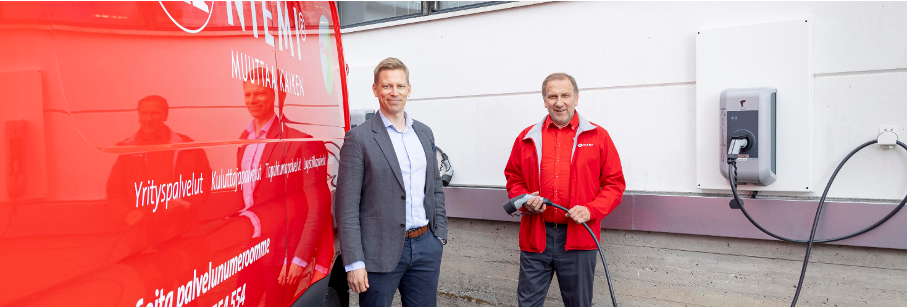
Reducing emissions from heavy commercial vehicles has received less attention compared to private cars. Neste’s Sales Director Tuomas Kulola and Niemi Services’ CEO Juha Niemi and Business Manager Ville Häyrynen want to encourage logistics companies to put more consideration on the environment by listing the five most important things in the electrification of the road haulage sector.
1. The right tools for the right purpose – electric cars are suitable for many but not all
According to Juha Niemi, CEO of Niemi Services, the advantage of electric vehicles is the quiet and comfortable ride combined with low operating costs. The current bottleneck in commercial transportation is their limited range.
Niemi’s bright red electric vehicles operate in relocation transports mainly in the Helsinki metropolitan area, from Niemi’s depot in Konala, Helsinki, where they are charged overnight. The limited range requires consideration when making daily route plans, says Ville Häyrynen, Business Manager at Niemi Services.
“If necessary, charging is also possible on the road, for example during a lunch break, but for long-distance driving we prefer renewable diesel or biogas. The most important thing is to choose the right type of equipment and fuel source for the right situation”, says Häyrynen.
Currently, the electric vehicles used by Niemi Services consist of vans and cars, but discussions are also underway with several manufacturers for the purchase of heavy trucks, Juha Niemi reveals.
Currently, Niemi Services’ fleet comprises of 167 vehicles, out of which 120 runs on renewable diesel, 39 on biogas and eight on electricity.
“We have been at the forefront of reducing traffic emissions for a long time, and we have just tightened our goal of achieving zero emissions for our fleet by 2030. Electricity together with renewable diesel and biogas play an important role in this,” says Niemi.
“Different alternative fuel sources have their own strengths, and the choice is worth making individually based on each need. Although there is a lot of talk about electrification right now, all the alternative fuel sources will still be needed well into the future. No single solution is enough to tackle climate challenge,” says Tuomas Kulola, Sales Director of Neste’s Marketing & Services business.
2. More charging points are needed – and location matters
The message from both Juha Niemi and Ville Häyrynen is that the charging infrastructure for electric vehicles is currently not comprehensive enough for the needs of commercial transportation. The charging network is fragmented into the hands of different suppliers. For example, shopping malls attract customers with the opportunity to charge an electric car.
“An 18-ton truck can’t even get to the mall’s parking garage,” Niemi laughs.
In practice, the only option for logistics companies is to build charging points at its own premises. This was also the case at the Niemi Services depot, where Neste has piloted its first electric charging service for logistics companies from the beginning of June 2021.
With the pilot project, Niemi will be able to charge several electric moving vehicles per day at its own office using 22 kilowatt (kW) AC chargers and a 180 kW DC quick charger.
The service is scheduled to be launched for customers in Finland by the end of 2021, Neste’s Kulola says.
“We have a comprehensive corporate customer base to which we supply renewable diesel and who are used to working with us. The electric vehicle charging service can easily be acquired as part of the current service package, and the customer doesn’t have to adopt new payment methods, for example,” says Kulola.
He emphasizes that building and ensuring a good customer experience is part of Neste’s strategy.
“We want to be together with our customers to reduce emissions and play our part in solving the climate challenge. Instead of the customer having to go to a charger further away to charge an electric vehicle, electric charging is available from us as an easy-to-use service, for example installed in their own depot. At the same time, we want to minimize unnecessary driving kilometers required by the customers for charging.”
3. Excel rows straight – where does the break-even point go?
The road to the electrification of the road haulage sector has in part the same limitations as passenger cars: the initial investment required is high. For heavy vehicles, the acquisition cost is about two to three times higher than for diesel-powered vehicles, Juha Niemi estimates.
In addition, building a charging station needed for heavy vehicles can be an investment of tens of thousands of euros. In addition to the price of the equipment, installation may require changes to the property’s electrical infrastructure as well as earthworks or other groundwork on the site.
Ville Häyrynen from Niemi Services urges logistics companies planning to electrify their vehicles to thoroughly consider their own requirements and the return of the investment. However, some of the costs are lower when using electricity, he reminds.
“The maintenance program is much lighter because electric motors are virtually maintenance-free. Operating costs per kilometer are also significantly lower, about a quarter compared to diesel.”
Neste’s new electric charging service currently in its pilot phase is designed to help facilitate the initial investment. Customers pay a monthly fee for the use of the charging service, and Neste takes care of installing the charger. The customer’s one-time investment will be any changes required to the property’s electrical infrastructure and earthworks, where Neste’s partners can help.
4. The head can’t be put in the bush – customers expect responsibility
When Niemi Services and Neste announced the pilot project for the electric vehicle charging service, Juha Niemi began to receive positive feedback from partners and customers.
“The feedback from customers was that it’s great how we are at the forefront in this matter as well. Whether it’s biogas, renewable diesel, or electricity, we are always happy to introduce new solutions that reduce emissions,” says Niemi.
“The cooperation with Neste has continued throughout our company’s 40-year history. It’s really great that we are able to work together with Neste to take this new step as well.”
5. Stick or carrot? Legislation and governance are changing the market rapidly
Both Niemi Services and Neste agree that EU directives, domestic legislation, and various control mechanisms, such as taxation and procurement subsidies, are rapidly revolutionizing the electric car market.
Neste’s Tuomas Kulola cites as an example the EU’s directive on clean public vehicle procurement, which entered into force in August 2021. It contributes radically to the competition between public vehicle procurement and logistics services.
From 2026 onwards, all vehicles and logistics services procured for the public sector must be emission-free. In the case of cars and vans, this means in practice all-electric cars, and in the case of heavy transport, vehicles running on biofuels, electricity, biogas or hydrogen.
“Finland’s goal is to be carbon neutral by 2035. In order to achieve this goal, the change applies equally to heavy traffic,” says Kulola. “In five years, we can already be well on our way to this goal, but more actions are needed. Passenger and commercial transportation of light vehicles will become electrified, that is clear. However, in the case of road haulage sector, renewable diesel will remain the driving force well into the future.”
Companies such as Niemi Services, which have invested heavily in reducing emissions for a long time without regulations, are strong in the new situation.
“No one can escape climate issues anymore,” Juha Niemi concludes.
